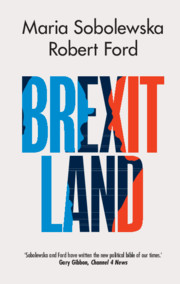Book contents
- Brexitland
- Reviews
- Brexitland
- Copyright page
- Contents
- Figures and tables
- Acknowledgements
- 1 Introduction: How Britain Became Brexitland
- Part I Demographic change and the emergence of new political divides over identity
- Part II Identity conflicts from New Labour to the Coalition
- 5 The Long Divorce: Parties and Voters Parting Ways
- 6 The Identity Conservative Insurgency and the Rise of UKIP
- 7 Change without Recovery: How the Coalition Catalysed Labour’s Demographic Transformation
- Part III Brexitland
- Bibliography
- Index
5 - The Long Divorce: Parties and Voters Parting Ways
from Part II - Identity conflicts from New Labour to the Coalition
Published online by Cambridge University Press: 21 September 2020
- Brexitland
- Reviews
- Brexitland
- Copyright page
- Contents
- Figures and tables
- Acknowledgements
- 1 Introduction: How Britain Became Brexitland
- Part I Demographic change and the emergence of new political divides over identity
- Part II Identity conflicts from New Labour to the Coalition
- 5 The Long Divorce: Parties and Voters Parting Ways
- 6 The Identity Conservative Insurgency and the Rise of UKIP
- 7 Change without Recovery: How the Coalition Catalysed Labour’s Demographic Transformation
- Part III Brexitland
- Bibliography
- Index
Summary
Chapter 5 focuses on the long-term political trends that helped to set the scene for Brexitland. Both Labour and the Conservatives changed in ways which alienated voters and eroded traditional partisan political identities. The two governing parties converged ideologically, and their elites became dominated by career politicians recruited from a limited number of graduate-dominated professions, reducing the differences between parties and narrowing the sections of society they represented. Voters responded to these changes by losing interest in politics and becoming more hostile to politicians, reflecting a growing belief that they were being denied a meaningful choice. This alienation was particularly acute among identity conservative voters, creating a political opportunity for a new issue or a new political force to mobilise the intense discontent of this group. Sure enough, in the second half of the New Labour governments, an issue emerged with the ability to realise this potential: immigration. We show how and why conflicts over immigration rose up the agenda in the later New Labour governments, and why this issue proved to be such a powerful lightning rod for discontent among identity conservatives.
Keywords
- Type
- Chapter
- Information
- BrexitlandIdentity, Diversity and the Reshaping of British Politics, pp. 121 - 155Publisher: Cambridge University PressPrint publication year: 2020

